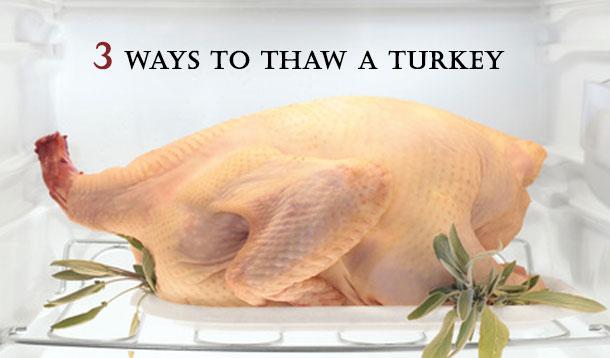
It's almost turkey time! If you're anything like me, you LOVE turkey dinner, but you get a bit squeamish at the thought of handling raw poultry. When it comes to thawing your turkey, you want to pay close attention to food safety in order to avoid cross-contamination and bacteria growth. The safest way to thaw a turkey is in the refrigerator, where the entire turkey will remain at a cool and at a safe temperature while thawing, or in cold water if you're tight for time.
A turkey is safe indefinitely while frozen (especially in a deep freeze), however when it starts to thaw, bacteria can start to grow. A package of frozen meat or poultry left on the counter at room temperature for any longer than two hours is unsafe. Even though the middle part of a turkey is still frozen, the outer layers are in the "danger zone" (between 4-140 degrees F), where foodborne pathogens can grow fast.
Place turkey breast side up in a clean container or on a clean platter that has elevated sides and corners to keep juices from leaking out. If on a platter, cover with plastic or lid. Always place the turkey, whether in a container or on a platter on the bottom shelf of your fridge in case juices run out, to prevent cross-contamination with other foods. The turkey should be defrosted for 5 hours per pound of bird (10 hours/kg).
Refrigerator thawing times according to size of turkey:
If you need to re-freeze defrosted turkey, it is safe to do so only if the meat is still cold and if ice crystals are still present. When in doubt, cook immediately and avoid re-freezing after thawing.
Make sure that your sink is wide enough and deep enough for your turkey to be fully immersed in cold drinking water. Thoroughly clean and sanitize your sink prior to defrosting. Wrap your turkey leak-proof plastic (or keep in original plastic wrapping) to avoid cross-contamination and place into a clean container for holding. Place your turkey breast-side-down and cover completely with cold drinking water. Change the water every 30-60 minutes to keep the surface cold until the entire turkey is thawed. Thawing your turkey in cold water takes about 1 hour per pound of bird (2 hours/kg).
Cold water thawing times according to size of turkey:
Your turkey can be refrigerated up to 48 hours prior to cooking after it has been thawed, however cooking it immediately is ideal.
You can safely thaw a turkey in the microwave (if it's smaller or if you're only cooking turkey parts like breasts). Make sure to follow your microwave's manufacturers instructions carefully and plan to cook it immediately after thawing because some areas may begin to cook or become too warm during microwaving. Partially cooked meat is not safe, as bacteria that are present will start to grow.
References:
Here are some tips and tricks to manage treat foods in your house, during the holidays (or anytime!).
And here are nine easy ways to make Thanksgiving a bit healthier for both you and your kids.
If you're a parent and want to learn more about how feeding your kids well, picky eating, family meals etc., jump on over to my facebook page for helpful tips, resources and recipes!